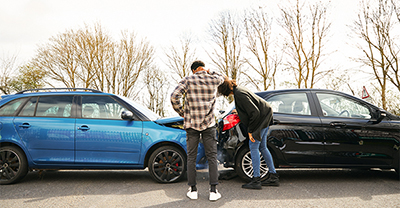Car insurance limits made simple: Know your coverage


0 min. read
Car insurance limits define the maximum amount an insurer may pay for a covered claim—and what you may have to cover yourself. Choosing the right limits can make a big difference in helping protect your finances after an accident. Whether you're meeting state minimums or opting for extra coverage, understanding how these limits work can help you make informed decisions about your policy.

Get a free quote and find coverage that works for you.
How car insurance limits work
The following standard auto insurance coverages use limits:
Liability car insurance coverage
Liability coverage can help protect you financially if you’re at fault in an accident, covering costs associated with injuries to others and damage to their property. Most states require you to carry auto liability insurance, which generally includes both bodily injury and property damage liability coverages.
Bodily injury liability per person: The maximum your insurer can pay for injuries to a single person
Bodily injury liability per accident: The maximum your insurer can cover for all injuries in one accident
Property damage liability: Covers damage to another person’s property when you’re at fault
Here’s an example: Let's say you're at fault in an accident injuring two people. Your Bodily Injury Liability coverage is $50,000 per person and $100,000 per accident. If one person's injuries cost $60,000, your insurance will only cover $50,000 (the per-person limit). Even though the total cost for both people is less than $100,000, the per-person limit applies. The other injured person's expenses would be covered, up to the remaining amount, within the per-accident total.
Personal injury protection (PIP) and medical payments coverage
PIP and medical payments (MedPay) coverage can help pay for medical expenses for you and your passengers after a covered accident, regardless of fault. PIP may also cover lost wages and other related expenses.
State requirements vary, however, and most states only offer one or the other. Review your policy documents or consult with an agent to understand how these coverages work in your specific situation.
Uninsured/underinsured motorist (UM/UIM) coverages
Uninsured and underinsured motorist coverages can help protect you financially if you’re injured, or your property is damaged, in an accident where the at-fault driver either doesn’t have auto insurance or doesn’t have enough coverage to pay for your losses.
Requirements for these coverages vary by state:
Some states require UM/UIM coverage
UM/UIM coverage may be optional in some states
Other states require insurance companies to offer it but allow drivers to decline it
In some states, UM/UIM coverage limits may need to match your liability limits, while in others, you may have the option to choose lower limits. Check with your agent for specific requirements in your state.
Physical damage coverage
Comprehensive and collision coverages—together known as physical damage coverage—don’t have state-mandated minimum limits. However, your vehicle’s value at the time of a claim typically determines the payout limit.
Comprehensive coverage can help pay for non-collision incidents like theft, vandalism, and certain weather-related damage
Collision coverage can help pay for damage caused by accidents with other vehicles or objects
If your car is damaged in an accident, your insurer will typically pay the reasonable cost of repairs for the accident-related damages up to the actual cash value (ACV), minus your deductible. ACV reflects depreciation, factoring in age, mileage, and condition. If you owe more on your loan than the ACV, you’re responsible for the difference.
Gap insurance, often available through your lender or financial institution, can help cover that shortfall. The coverage may also be available through your personal auto policy. Dairyland offers a comparable option called Car Loan Protection.
Why car insurance limits matter
Car insurance limits are important because they determine the maximum amount your insurance can pay out for a covered claim. If costs exceed your limits, you’ll need to cover the difference—but there are ways to help balance affordability and protection.
Limits affect your out-of-pocket costs in an accident
If damages exceed your policy limits, you’re responsible for the difference. For example, let’s say you’re at fault in an accident that results in $30,000 in property damage for the other driver. If your property damage liability limit is $20,000, you may need to cover the remaining $10,000 yourself.
This is why it’s important to consider coverage that fits your budget while also providing a financial safety net. Even a small increase in limits can offer added protection without a major impact on your premium.
Higher limits offer more financial protection
While higher limits may increase your premium, they can also provide a valuable buffer against unexpected expenses. With rising medical costs and vehicle repair prices, even a minor accident can become costly. Many drivers find that a modest increase in coverage can provide much-needed peace of mind.
Relationship between limits and premiums
Generally, choosing higher coverage limits can increase your premium, but the cost difference is often less than the potential financial risk. If affordability is a concern, you may want to explore coverage options that balance protection with a manageable monthly cost.
Choosing the right car insurance limits
Selecting appropriate car insurance limits depends on various factors, including state requirements, your budget, and your level of comfort with financial risk. Consulting with a licensed insurance agent can help you determine the coverage amount that’s right for you.
Consider the following:
Your budget and financial situation:
If affordability is a concern, start by comparing coverage options within your price range. Even slightly higher limits may offer more protection for a small difference in premium.
State minimum requirements:
Meeting state minimums keeps you legally covered, but it’s helpful to check if slightly higher limits make sense for your needs.
Deductibles:
Remember that deductibles also apply to certain coverages, such as collision and comprehensive. You'll pay your deductible, then your insurance can cover the remaining amount up to your coverage limit.
Your personal risk tolerance:
Some drivers prefer the lowest-cost option, while others choose added protection for peace of mind. Finding the right balance is key.
Driving habits and environment:
Factor in how often you drive, where you typically travel, and the type of vehicle you own. If you put a lot of miles on your car or drive a high-value vehicle, you might benefit from higher limits due to increased risk exposure.
Common misconceptions about car insurance limits
Misunderstanding your auto insurance policy can lead to unexpected out-of-pocket costs. Here are some common myths to be aware of:
State minimum limits provide enough coverage
State minimums meet legal requirements, but they may not always cover all expenses after an accident. If affordability is a concern, consider exploring options that provide extra protection within your budget. Even a small increase in coverage limits can help reduce financial stress in the event of a serious claim.
"Full coverage” means you're fully protected
The term "full coverage" is commonly used to describe a policy that includes liability, collision, and comprehensive coverage, but it doesn’t mean unlimited protection and may not include other available coverages, such as rental or roadside assistance. Reviewing your policy details can help you understand what’s covered and where gaps may exist.
Higher limits are always unaffordable
While higher limits can increase your premium, the difference is often smaller than expected. Many insurers, including Dairyland, offer flexible options to help balance affordability with protection. If you’re concerned about cost, an agent can help you explore coverage levels that fit your budget.
Making an informed decision about your coverages
Review your car insurance coverage limits periodically, especially after major life changes like marriage, a new home, or a shift in your financial situation. This helps ensure your coverage continues to meet your evolving needs.
If you want to learn more about car insurance limits or explore your coverage options, contact us today. Our experienced agents at Dairyland®, a brand of the Sentry Insurance Group, can explain how different limits impact your premium and help you find coverage that fits your needs and budget.

The general information in this blog is for informational or entertainment purposes only. View our blog disclaimer.















